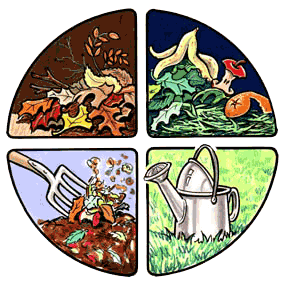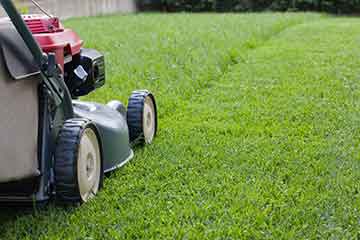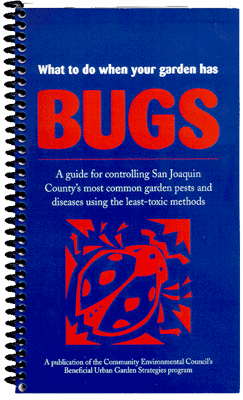
In exchange for training from the University, UC Master Gardeners offer volunteer services and education to the general public. Topics include: the reduction and reuse of green waste, resource conservation, sustainable landscaping practices, landscape trees and ornamentals, fruit and vegetable growing, weed and pest management and many other home horticulture related topics.
Master Gardeners are also involved in the planning and preparation of school and community based gardens. The program has a FREE hotline (953-6112) for residents who have gardening-related questions. The office is staffed by volunteers Tuesday - Thursday from 9 a.m. – noon. Master Gardeners can be found at local festivals, farmers markets and monthly weekend workshops. For more information, visit the Master Gardener website.

There are several ways to begin. You may purchase a composting bin, make your own, or designate an open area in your yard for a compost pile. A food scrap container located in the kitchen should be small enough to empty often. This frequent emptying helps avoid unnecessary odors. Now the fun begins!
Compost need four essential ingredients:
-Nitrogen (Green Waste)
-Carbon (Woody Waste)
-Oxygen (air)
-Water (moisture)
Nitrogen: Any green organics such as houseplant or flower trimmings, lawn clippings (if you aren't grasscycling), contain nitrogren. All vegetable and fruit scraps are also in the nitrogen group.
Carbon: Brown (dry) grass and leaves, paper and cardboard (shredded or in small pieces), plus bread and grains.
Oxygen: The bin or pile must be turned occasionally to allow air to circulate through the mixture.
Water: Keep your compost mixture moist but not dripping wet.
Mix: Apply equal amounts of browns and greens, water to keep moist, and turn occasionally. Make sure to avoid food items that contain grease and oils, any meat or dairy products, and fish to avoid odors and rodents. Throw in a few red worms to hasten the composting process along! Those red wigglers love the warm environment, multiply quickly, make wonderful compost, and provide great bait for fishing!
After about 2-4 months, a rich, dark soil will replace the garden and food scraps. Congratulations! With a little effort and lots of organics, you have made your own compost AND reduced your trash by approximately 25 percent!
For more information on composting, check out these Web sites:
 Lose the Bag! Grasscycle! Fertilizing your lawn and garden can be much less expensive and less toxic by using natural products. Grasscycling lawn clippings (leaving them on the lawn) saves time (no more bagging), saves money (reduces the amount of fertilizer needed by 15-20%), and encourages a healthier lawn. Grass clippings contain valuable nitrogen. Keeping the grass clippings out the landfill also saves valuable landfill space and saves the energy used to haul the clippings out to the landfill.
Lose the Bag! Grasscycle! Fertilizing your lawn and garden can be much less expensive and less toxic by using natural products. Grasscycling lawn clippings (leaving them on the lawn) saves time (no more bagging), saves money (reduces the amount of fertilizer needed by 15-20%), and encourages a healthier lawn. Grass clippings contain valuable nitrogen. Keeping the grass clippings out the landfill also saves valuable landfill space and saves the energy used to haul the clippings out to the landfill.Over-fertilizing in general is not healthy for your lawn, plus much of the fertilizer may be washed away by over-watering. By leaving the lawn clippings on the lawn, you reintroduce organics and nutrients back into the soil. you might see some traces of grass clippings right after you mow, but within a few hours, they dry up like they were never even there. you may still have to fertilize when you use the grasscycling technique, but you can increase the intervals between feedings and reduce the amount of fertilizer that you use by 10-20%. Why not try some organic fertilizer such as bat guano, poultry or steer manure? Or if you're really adventurous, create your own blend of fertilizer made up of natural ingredients, such as bone meal, greensand, kelp powder and compost or manure. Natural fertilizers dispense nutrients slowly and over a longer period, strengthening root systems and leaving your lawn looking great.
The BUGS Program is a pesticide reduction program for use by the San Joaquin County home gardener. The BUGS book has fact sheets for residents interested in learning more about less-toxic alternatives to pesticides and herbicides used to control garden pests and diseases.
What you will find inside our BUGS book: -About BUGS
-About BUGS
-Aphids and Other Sapsuckers (Mealy bugs, scale, whiteflies, spider mites, leafhoppers)
-Caterpillars and Cutworms
-Earwigs
-Snails and Slugs
-Gophers
-Fleas
-Rose Diseases (Powdery mildew, rust, and black spots)
-Garden Weeds
-Mistletoe
-Beneficial Insects
-Plants That Attract Beneficial Insects
-Resources
Contact San Joaquin County Public Works Department, Solid Waste Division at (209) 468-3066 for your FREE copy while supplies last!
A great Website to visit is The Greenscapes Massachusetts Coalition:
Solid Waste Administrative Office
1810 East Hazelton Avenue
Stockton, CA 95205
Phone: (209) 468-3066
Fax: (209) 468-3078
Hours: 8:00am to 5:00pm
Email us with questions at: solidwaste@sjgov.org